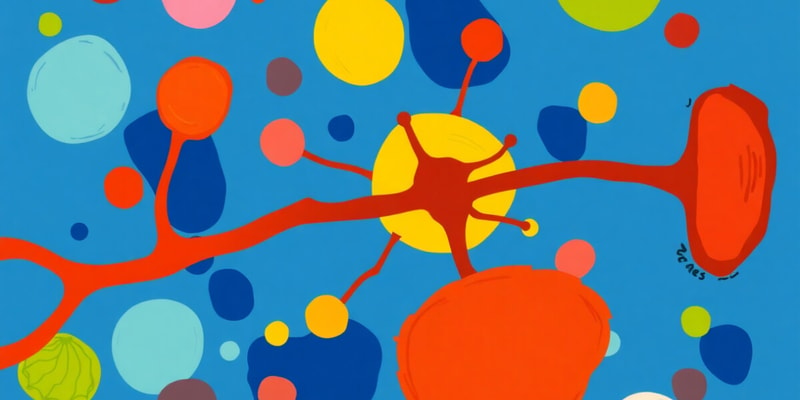Podcast
Questions and Answers
What role does histamine play in the body?
What role does histamine play in the body?
Which of the following statements about autocoids is true?
Which of the following statements about autocoids is true?
Where is histamine primarily synthesized in the body?
Where is histamine primarily synthesized in the body?
What is the main enzyme involved in the synthesis of histamine?
What is the main enzyme involved in the synthesis of histamine?
Signup and view all the answers
Which of the following is NOT a characteristic of histamine?
Which of the following is NOT a characteristic of histamine?
Signup and view all the answers
What distinguishes first-generation antihistamines from second-generation antihistamines?
What distinguishes first-generation antihistamines from second-generation antihistamines?
Signup and view all the answers
Which of the following drugs is classified as a partially sedating second-generation antihistamine?
Which of the following drugs is classified as a partially sedating second-generation antihistamine?
Signup and view all the answers
What is a common adverse effect associated with first-generation antihistamines?
What is a common adverse effect associated with first-generation antihistamines?
Signup and view all the answers
What are second-generation antihistamines specifically characterized by regarding their pharmacokinetics?
What are second-generation antihistamines specifically characterized by regarding their pharmacokinetics?
Signup and view all the answers
Which of the following correctly describes the actions of H1-receptor blockers?
Which of the following correctly describes the actions of H1-receptor blockers?
Signup and view all the answers
What is the primary mechanism of action for triptans?
What is the primary mechanism of action for triptans?
Signup and view all the answers
Which of the following is true about the pharmacokinetics of sumatriptan?
Which of the following is true about the pharmacokinetics of sumatriptan?
Signup and view all the answers
What is the most common adverse effect associated with triptan use?
What is the most common adverse effect associated with triptan use?
Signup and view all the answers
How effective is the first dose of triptans in aborting a migraine?
How effective is the first dose of triptans in aborting a migraine?
Signup and view all the answers
What should be done before administering triptans to certain patients?
What should be done before administering triptans to certain patients?
Signup and view all the answers
What is a common pattern of headache occurrence after taking triptans?
What is a common pattern of headache occurrence after taking triptans?
Signup and view all the answers
What distinguishes Zolmitriptan from other triptans in terms of administration?
What distinguishes Zolmitriptan from other triptans in terms of administration?
Signup and view all the answers
Which of the following statements about the variability of triptan response is true?
Which of the following statements about the variability of triptan response is true?
Signup and view all the answers
Why are beta blockers not recommended as initial therapy for migraine prevention in certain patients?
Why are beta blockers not recommended as initial therapy for migraine prevention in certain patients?
Signup and view all the answers
What is the primary drug class recommended for migraine prophylaxis?
What is the primary drug class recommended for migraine prophylaxis?
Signup and view all the answers
Which medication is suggested for patients with depression as an option for migraine prevention?
Which medication is suggested for patients with depression as an option for migraine prevention?
Signup and view all the answers
Which of the following is NOT an alternative medication for migraine prophylaxis?
Which of the following is NOT an alternative medication for migraine prophylaxis?
Signup and view all the answers
What are reasonable options for migraine prevention in patients with epilepsy?
What are reasonable options for migraine prevention in patients with epilepsy?
Signup and view all the answers
For patients suffering from insomnia, which medication is considered a reasonable option for migraine prevention?
For patients suffering from insomnia, which medication is considered a reasonable option for migraine prevention?
Signup and view all the answers
In cluster headache treatment, which method is used as a first-line abortive strategy?
In cluster headache treatment, which method is used as a first-line abortive strategy?
Signup and view all the answers
For a patient with hypertension who is 30 years old and a non-smoker, which medication would be a reasonable option for migraine prophylaxis?
For a patient with hypertension who is 30 years old and a non-smoker, which medication would be a reasonable option for migraine prophylaxis?
Signup and view all the answers
Which drug is recommended for obesity in the context of migraine prevention?
Which drug is recommended for obesity in the context of migraine prevention?
Signup and view all the answers
Which of the following is a common initial treatment suggested for patients with episodic migraine?
Which of the following is a common initial treatment suggested for patients with episodic migraine?
Signup and view all the answers
What is recommended for patients with Raynaud phenomenon in terms of migraine prevention?
What is recommended for patients with Raynaud phenomenon in terms of migraine prevention?
Signup and view all the answers
Which CGRP antagonist is injected and has shown effectiveness in migraine treatment?
Which CGRP antagonist is injected and has shown effectiveness in migraine treatment?
Signup and view all the answers
Which patient group requires discussion about potential risks of pharmacotherapy due to their reproductive status?
Which patient group requires discussion about potential risks of pharmacotherapy due to their reproductive status?
Signup and view all the answers
Which of the following is NOT considered a reasonable option for migraine prevention?
Which of the following is NOT considered a reasonable option for migraine prevention?
Signup and view all the answers
What is the preferred therapy for symptom relief of tension headaches?
What is the preferred therapy for symptom relief of tension headaches?
Signup and view all the answers
Which combination of medications would NOT be appropriate for a patient who is a smoker and over 60 years old with hypertension?
Which combination of medications would NOT be appropriate for a patient who is a smoker and over 60 years old with hypertension?
Signup and view all the answers
Which class of drugs is often used for migraine prophylaxis but is NOT a β-blocker?
Which class of drugs is often used for migraine prophylaxis but is NOT a β-blocker?
Signup and view all the answers
Which of the following medications is specifically categorized as an anticonvulsant used for migraine prophylaxis?
Which of the following medications is specifically categorized as an anticonvulsant used for migraine prophylaxis?
Signup and view all the answers
What is a primary mechanism of action for Ergotamine?
What is a primary mechanism of action for Ergotamine?
Signup and view all the answers
What significant risk is associated with using ergotamine within 24 hours of triptans?
What significant risk is associated with using ergotamine within 24 hours of triptans?
Signup and view all the answers
Which of the following is a contraindication for the use of Lasmiditan?
Which of the following is a contraindication for the use of Lasmiditan?
Signup and view all the answers
Which of the following statements accurately describes Dihydroergotamine?
Which of the following statements accurately describes Dihydroergotamine?
Signup and view all the answers
What class of medication does Rimegepant belong to?
What class of medication does Rimegepant belong to?
Signup and view all the answers
What is the common side effect associated with CGRP receptor antagonists?
What is the common side effect associated with CGRP receptor antagonists?
Signup and view all the answers
In what situation is prophylaxis for migraine headaches indicated?
In what situation is prophylaxis for migraine headaches indicated?
Signup and view all the answers
Which of the following drugs should Ubrogepant not be used with due to interactions?
Which of the following drugs should Ubrogepant not be used with due to interactions?
Signup and view all the answers
What role does dopamine receptor action play in Dihydroergotamine's mechanism?
What role does dopamine receptor action play in Dihydroergotamine's mechanism?
Signup and view all the answers
Which drug is indicated for acute treatment of migraines?
Which drug is indicated for acute treatment of migraines?
Signup and view all the answers
What condition could arise from dependence on Dihydroergotamine?
What condition could arise from dependence on Dihydroergotamine?
Signup and view all the answers
What type of treatment does Rimegepant provide for patients?
What type of treatment does Rimegepant provide for patients?
Signup and view all the answers
What is a major downside of using potent CYP3A4 inhibitors in conjunction with Dihydroergotamine?
What is a major downside of using potent CYP3A4 inhibitors in conjunction with Dihydroergotamine?
Signup and view all the answers
Study Notes
Drugs with Important Actions on Smooth Muscles - Histamine and Serotonin
- Overview: Histamine, serotonin, and prostaglandins are autocoids, local hormones produced by tissues rather than endocrine glands. This chapter covers these autocoids and antagonists.
Histamine
- Chemical Messenger: Primarily generated in mast cells, mediating cellular responses like allergic and inflammatory reactions, gastric acid secretion, and neurotransmission.
- Clinical Application: No clinical drug applications for histamine exists, but agents inhibiting its activity are therapeutically important.
- Location: Found in high concentrations in tissues like lungs, skin, blood vessels, and the gastrointestinal tract, especially in mast cells and basophils. It also functions as a neurotransmitter in the brain.
- Synthesis: Formed by decarboxylation of the amino acid histidine by the enzyme histidine decarboxylase.
- Release: Released from tissues in response to various stimuli; including cell destruction (cold, toxins), insect/spider venoms, and trauma. Allergies/anaphylaxis can also trigger histamine release.
- Mechanism of Action: Acts via histamine receptors (H1, H2, H3, H4). H1 and H2 receptors are clinically relevant drug targets. Histamine affects smooth muscle contraction, vascular dilation, and capillary permeability.
- Role in Allergy/Anaphylaxis: Symptoms result from the release of several mediators including histamine, serotonin, leukotrienes, and eosinophil chemotactic factor of anaphylaxis; these can cause localized allergic reactions or full-blown anaphylaxis.
H1 Receptors
- Exocrine Excretion: Increased mucus production, especially nasal and bronchial, causing respiratory symptoms.
- Bronchial Smooth Muscle: Bronchiole constriction, leading to asthma symptoms and reduced lung capacity.
- Intestinal Smooth Muscle: Constriction causing cramps and diarrhea.
- Sensory Nerve Endings: Causes itching and pain.
H1 and H2 Receptors
- Cardiovascular System: Lowering of systemic blood pressure; positive chronotropism (H2) and positive inotropism (H1 and H2).
- Skin: Dilation and increased capillary permeability resulting in fluid and protein leakage; "triple response" (wheal formation, redness, flare).
- Stomach: Stimulation of gastric hydrochloric acid secretion.
H1 Antihistamines
- Overview: Referred to as antihistamines, primarily as H1-receptor blockers. Divided into first and second generation.
- First Generation: Older, inexpensive, but effective in their action. Penetrate the central nervous system (CNS), causing sedation, interacting with other receptors.
- Second Generation: More specific to peripheral, H1 receptors. Do not enter the CNS and cause less sedation than first-generation, but some of these can be sedating.
- Actions: These compounds work by blocking the receptor-mediated response of a tissue. They are more effective in preventing symptoms than in reversing established ones.
- Therapeutic Uses: Allergic and inflammatory conditions, including allergic rhinitis, urticaria, and allergic conjunctivitis. Also useful for motion sickness,
- Pharmacokinetics: Well absorbed after ingestion, with maximum serum levels within 1-2 hours; varying average plasma half-lives.
- Adverse Effects: Drowsiness, fatigue, dizziness, lack of coordination, tremors, blurred vision, and urinary retention. Other drug interactions are also possible.
Serotonin
- Neurotransmitter: Plays a role in vasoconstriction, inhibition of gastric secretion, and smooth muscle contraction in the enteric nervous system and CNS.
- Location/Synthesis: Found in enterochromaffin cells of the gastrointestinal tract, platelets, and raphe nuclei of the brainstem. Synthesized from tryptophan.
- Mechanism of Action: Several types of serotonin receptors, mostly G protein-coupled, controlling numerous physiological responses.
- Therapeutic Use: Agonists and antagonists used for disorders like depression and migraine headache.
Migraine
- Types: Two main types: migraine with aura (preceded by neurologic symptoms like visual disturbance) and without aura.
- Triggers and Symptoms: Symptoms include severe, unilateral, pulsating headaches, lasting 2-72 hours; aggravated by physical activity; and associated with nausea, vomiting, sensitivity to light/sound.
- Treatment and Prophylaxis: Abortive treatments (serotonin agonists, ergot alkaloids) and prophylactic therapies.
Additional Notes
- Key terms like selective serotonin reuptake inhibitors (SSRIs), serotonin and norepinephrine reuptake inhibitors (SNRIs) are discussed in context with clinical depression, but not separately.
- Specific details about some medications (such as dosage, exact mechanisms, and drug interactions) are not present here.
Studying That Suits You
Use AI to generate personalized quizzes and flashcards to suit your learning preferences.
Related Documents
Description
This quiz explores the important actions of histamine and serotonin on smooth muscles as autocoids. You will learn about their synthesis, release mechanisms, and clinical implications, including the therapeutic significance of histamine antagonists. Test your knowledge on these crucial chemical messengers and their roles in various physiological responses.





